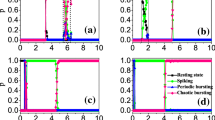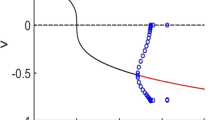Abstract
The present work is on the spatiotemporal activities and effects of chaotic neurons in a pulse-coupled biological neural network. The biological neural network used is that of Caenorhabditis elegans. Because of its similarity to human neural network, it can be used to understand the simple dynamics of human brain. Within the network the neurons are found to exhibit chaotic nature, even though their parameters are that of normal neurons. It is observed that when the strength of synaptic conductance is increased, initially the bursting synchronization, entropy of the network and the average firing rate decrease slightly and then increase. Since chaotic dynamics of neuron plays an important role in human brain functions, the neurons of the network are intentionally made chaotic and the dynamics is studied. As the neurons of the network are made chaotic, ‘near-death’-like surges of neuron activity before ending firing is observed throughout the network. Also, the brain dynamics changes from alert to rest state. When most of the neurons of the network are made chaotic, their activities become independent of the coupling strength.
















Similar content being viewed by others
Change history
27 March 2018
There is a typographical error in Eq. (1) of the original article, where ‘w’, the membrane potential, should be squared in the first term on the right-hand side.
References
Izhikevich, E.M.: Dynamical Systems in Neuroscience. MIT Press, Cambridge (2014)
Resmi, V., Ambika, G., Amritkar, R.E.: General mechanism for amplitude death in coupled systems. Phys. Rev. E 84, 46212 (2011)
Zou, W., Senthilkumar, D.V., Koseska, A., Kurths, J.: Generalizing the transition from amplitude to oscillation death in coupled oscillators. Phys. Rev. E 88, 50901 (2013)
Banerjee, T., Biswas, D.: Amplitude death and synchronized states in nonlinear time-delay systems coupled through mean-field diffusion. Chaos Interdiscip. J. Nonlinear Sci. 23, 43101 (2013)
Thottil, S.K., Ignatius, R.P.: Nonlinear feedback coupling in Hindmarsh–Rose neurons. Nonlinear Dyn. 87(3), 1879–1899 (2017)
Ma, J., Tang, J.: A review for dynamics of collective behaviors of network of neurons. Sci. China Technol. Sci. 58(12), 2038–2045 (2015)
Hizanidis, J., Kouvaris, N.E., Gorka, Z.-L., Díaz-Guilera, A., Antonopoulos, C.G.: Chimera-like states in modular neural networks. Sci. Rep. 6, 19845 (2016)
Tsigkri-DeSmedt, N.D., Hizanidis, J., Hovel, P., Provata, A.: Multi-chimera states in the Leaky Integrate-and-Fire model. Procedia Comput. Sci. 66, 13–22 (2015)
Ermentrout, B.: Neural networks as spatio-temporal pattern-forming systems. Rep. Prog. Phys. 61, 4 (1998)
Ma, J., Wang, C., Jin, W.: Pattern selection and self-organization induced by random boundary initial values in a neuronal network. Phys. A Stat. Mech. Appl. 461, 586–594 (2016)
Panaggio, M.J., Abrams, D.M.: Chimera states: Coexistance of coherence and incoherence in networks of coupled oscillators. Nonlinearity 28, 3 (2015)
Bogaard, A., Parent, J., Zochowski, M., Booth, V.: Interaction of cellular and network mechanisms in spatiotemporal pattern formation in neuronal networks. J. Neurosci. 29(6), 1677–1687 (2009)
Wang, Q., Zheng, Y., Ma, J.: Cooperative dynamics in neuronal networks. Chaos Solitons Fractals 56, 19–27 (2013)
Erichsen Jr., R., Brunnet, L.G.: Multistability in networks of Hindmarsh–Rose neurons. Phys. Rev. E. 78, 61917 (2008)
Jia, Y., Gu, H.: Transition from double coherence resonances to single coherence resonance in a neuronal network with phase noise. Chaos An Interdiscip. J. Nonlinear Sci. 25, 123124 (2015)
Feng, Y., Li, W.: Analysis on the synchronized network of Hindmarsh–Rose neuronal models. J. Phys. Conf. Ser. 604, 12006 (2015)
Acker, C.D., Kopell, N., White, J.A.: Synchronization of strongly coupled excitatory neurons: relating network behavior to Biophysics. J. Comput. Neurosci. 15(1), 71–90 (2003)
Luccioli, S., Politi, A.: Collective behavior of heterogeneous neural networks. Phys. Rev. Lett. 105, 158104 (2010)
Cichy, R.M., Khosla, A., Pantazis, D., Torralba, A., Oliva, A.: Comparison of deep neural networks to spatio-temporal cortical dynamics of human visual object recognition reveals hierarchical correspondence. Sci. Rep. 6, 27755 (2016)
Chen, Y., Rangarajan, G., Ding, M.: Stability of synchronized dynamics and pattern formation in coupled systems: review of some recent results. Commun. Nonlinear Sci. Numer. Simul. 11, 934–960 (2006)
Destexhe, A.: Stability of periodic oscillations in a network of neurons with time delay. Phys. Lett. A. 187(4), 309–316 (1994)
Wang, H., Chen, Y.: Spatiotemporal activities of neural network exposed to external electric fields. Nonlinear Dyn. 85(2), 881–891 (2016)
Sprott, J.C.: Chaotic dynamics on large networks. Chaos Interdiscip. J. Nonlinear Sci. 18, 23135 (2008)
Wu, J., Xu, Y., Ma, J.: Levy noise improves the electrical activity in a neuron under electromagnetic radiation. PLoS One 12(3), e0174330 (2017)
Roxin, A., Brunel, N., Hansel, D.: Role of delays in shaping spatiotemporal dynamics of neuronal activity in large networks. Phys. Rev. Lett. 94, 238103 (2005)
Keplinger, K., Wackerbauer, R.: Transient spatiotemporal chaos in the Morris–Lecar neuronal ring network. Chaos Interdiscip. J. Nonlinear Sci. 24, 13126 (2014)
Truccolo, W., Hochberg, L.R., Donoghue, J.P.: Collective dynamics in human and monkey sensorimotor cortex: predicting single neuron spikes. Nat. Neurosci. 13(1), 105–111 (2010)
Fink, C.G., Booth, V., Zochowski, M.: Cellularly-driven differences in network synchronization propensity are differentially modulated by firing frequency. PLoS Comput. Biol. 7(5), e1002062 (2011)
Garbo, A.Di, Barbi, M., Chillemi, S., Alloisio, S., Nobile, M.: Calcium signalling in astrocytes and modulation of neural activity. BioSystems 89, 74–83 (2007)
Guo, S., Tang, J., Ma, J., Wang, C.: Autaptic modulation of electrical activity in a network of neuron-coupled astrocyte. Compexity 2017, 4631602 (2017)
Tang, J., Zhang, J., Ma, J., Zhang, G., Yang, X.: Astrocyte calcium wave induces seizure-like behavior in neuron network. Sci. China Technol. Sci. 60(7), 1011–1018 (2017)
Freeman, W.J.: Role of chaotic dynamics in neural plasticity. Prog. Brain Res. 102, 319–333 (1994)
Sato, W., Kochiyama, T., Uono, S.: Spatiotemporal neural network dynamics for the processing of dynamic facial expressions. Sci. Rep. 5, 12432 (2015)
Korn, H., Faure, P.: Is there chaos in the brain ? II. Experimental evidence and related models. C. R. Biol. 326, 787–840 (2003)
Varshney, L.R., Chen, B.L., Paniagua, E., Hall, D.H., Chklovskii, D.B.: Structural properties of the Caenorhabditis elegans neuronal network. PLoS Comput. Biol. 7(2), e1001066 (2011)
Antonopoulos, C.G., Fokas, A.S., Bountis, T.C.: Dynamical complexity in the C. elegans neural network. Eur. Phys. J. Spec. Top 225(6–7), 1255–1269 (2016)
Kosinski, R.A., Zaremba, M.: Dynamics of the model of the Caenorhabditis elegans neural network. Acta Phys. Pol. B. 38(6), 2201–2210 (2007)
Izhikevich, E.M.: Simple model of spiking neurons. IEEE Trans. Neural Netw. 14, 6 (2003)
Izhikevich, E.M.: Which model to use for Cortical spiking neurons. IEEE Trans. Neural Netw. 15, 5 (2004)
Izhikevich, E.M.: Hybrid spiking models. Philos. Trans. R. Soc. A. 368, 5061–5070 (2010)
Altun, Z.F., Hall, D.H.: Nervous System, General Description. http://www.wormatlas.org/hermaphrodite/nervous/Neuroframeset.html
Kaiser, M., Hilgetag, C.C.: Nonoptimal component placement, but short processing paths, due to long-distance projections in neural systems. PLoS Comput. Biol. 2(7), e95 (2006)
Kotter, R.: Online retrieval, processing, and visualization of primate connectivity data from the CoCoMac database. Neuroinformatics 2(2), 127–144 (2004)
Choe, Y., McCormick, B., Koh, W.: Network connectivity analysis on the temporally augmented C. elegans web : A pilot study. Soc. Neurosci. Abstr. 30, 921.9 (2004)
Dorval, A.D.: Probability distributions of the logarithm of inter-spike intervals yield accurate entropy estimates from small datasets. J. Neurosci. Methods. 173(1), 129–139 (2008)
Dur-e-Ahmad, M., Nicola, W., Campbell, S.A., Skinner, F.K.: Network bursting using experimentally constrained single compartment CA3 hippocampal neuron models with adaptation. J. Comput. Neurosci. 33(1), 21–40 (2012)
Jin, W., Lin, Q., Wang, A., Wang, C.: Computer simulation of noise effects of the neighborhood of stimulus threshold for a Mathematical model of homeostatic regulation of sleep-wake cycles. Compexity 2017, 4797545 (2017)
Chawla, L.S., Akst, S., Junker, C., Jacobs, B.R.N., Seneff, M.G.: Surges of Electroencephalogram activity at the time of death: a case series. J. Palliat. Med. 12(12), 1095–1100 (2009)
Norton, L., Gibson, R.M., Gofton, T., Benson, C., Dhanani, S., Shemie, S.D., Hornby, L., Ward, R., Young, G.B.: Electroencephalographic recordings during withdrawal of life-sustaining therapy until 30 minutes after declaration of death. Can. J. Neurol. Sci. 44(2), 139–145 (2017)
Author information
Authors and Affiliations
Corresponding author
Rights and permissions
About this article
Cite this article
Mineeja, K.K., Ignatius, R.P. Spatiotemporal activities of a pulse-coupled biological neural network. Nonlinear Dyn 92, 1881–1897 (2018). https://doi.org/10.1007/s11071-018-4169-2
Received:
Accepted:
Published:
Issue Date:
DOI: https://doi.org/10.1007/s11071-018-4169-2




